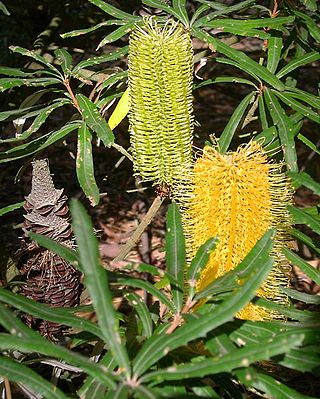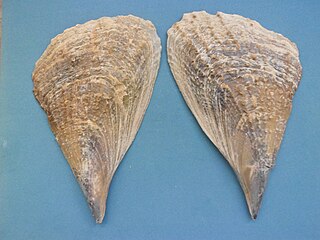
A mushroom or toadstool is the fleshy, spore-bearing fruiting body of a fungus, typically produced above ground, on soil, or on its food source. Toadstool generally denotes one poisonous to humans.

Amanita muscaria, commonly known as the fly agaric or fly amanita, is a basidiomycete of the genus Amanita. It is a large white-gilled, white-spotted, and usually red mushroom.

Edible mushrooms are the fleshy fruit bodies of several species of macrofungi. Edibility may be defined by criteria including the absence of poisonous effects on humans and desirable taste and aroma. Mushrooms that have a particularly desirable taste are described as "choice". Edible mushrooms are consumed for their nutritional and culinary value. Mushrooms, especially dried shiitake, are sources of umami flavor.

The spore print is the powdery deposit obtained by allowing spores of a fungal fruit body to fall onto a surface underneath. It is an important diagnostic character in most handbooks for identifying mushrooms. It shows the colour of the mushroom spores if viewed en masse.

Lepiota is a genus of gilled mushrooms in the family Agaricaceae. All Lepiota species are ground-dwelling saprotrophs with a preference for rich, calcareous soils. Basidiocarps are agaricoid with whitish spores, typically with scaly caps and a ring on the stipe. Around 400 species of Lepiota are currently recognized worldwide. Many species are poisonous, some lethally so.

The Agaricaceae are a family of basidiomycete fungi and include the genus Agaricus, as well as basidiomycetes previously classified in the families Tulostomataceae, Lepiotaceae, and Lycoperdaceae.

Pleurotus ostreatus, the oyster mushroom, oyster fungus, hiratake, or pearl oyster mushroom is a common edible mushroom. It is one of the more commonly sought wild mushrooms, though it can also be cultivated on straw and other media.

Amanita citrina, commonly known as the false death cap or citron amanita, is a basidiomycotic mushroom, one of many in the genus Amanita. It grows in silicate soil in the summer and autumn months. It bears a pale yellow or sometimes white cap, with white stem, ring and volva. It is an inedible mushroom due to its toxicity, but is more pertinently often confused for the lethal death cap.

Banksia seminuda, commonly known as the river banksia, is a tree in the plant genus Banksia. It is found in south west Western Australia from Dwellingup (32°42′ S) to the Broke Inlet east of Denmark (34°57′ S). It is often mistaken for, and was originally considered a subspecies of, the Banksia littoralis. Stephen Hopper described the subspecies remanens as a short-leaved shrubby form found in the coastal sands below granite outcrops in the Walpole-Nornalup National Park, however George does not feel this form warrants taxonomic recognition as it lies within the normal variability of the species and there was no clear distinction between it and the other populations of B. seminuda.

Suillus granulatus is a pored mushroom of the genus Suillus in the family Suillaceae. It is similar to the related S. luteus, but can be distinguished by its ringless stalk. Like S. luteus, it is an edible mushroom that often grows in a symbiosis (mycorrhiza) with pine. It has been commonly known as the weeping bolete, or the granulated bolete. Previously thought to exist in North America, that species has now been confirmed to be the rediscovered Suillus weaverae.

Echinoderma asperum or Lepiota aspera, sometimes known commonly as the freckled dapperling, is a large, brownish, white-gilled mushroom, with a warty or scaly cap. It lives in woodland, or on bark chips in parks, and gardens.

Cystolepiota is a genus of mushroom-forming fungi in the family Agaricaceae.

Cystodermella cinnabarina is a basidiomycete fungus of the genus Cystodermella. Its fruiting body is a small agaric bearing a distinctive reddish-coloured grainy cap. It occurs in coniferous and deciduous forests throughout the world. Prior to 2002, this species belonged to genus Cystoderma, subsection Cinnabarina, under the name Cystoderma cinnabarinum which is still sometimes applied. Another often used synonym is Cystoderma terreyi.

Cystolepiota bucknallii is a species of basidiomycete fungus of the genus Cystolepiota. Found throughout Europe, it is a rare fungus occurring in deciduous forests. The small fruit bodies bear a distinctive smell of coal gas and appear in autumn on damp ground. It is not an edible mushroom.

Lycoperdon mammiforme is a rare, inedible type of puffball mushroom in the genus Lycoperdon, found in deciduous forest on chalk soil. It is found in Europe. The fruit body is spherical to pear shaped, at first pure white with slightly grainy inner skin and an outer skin which disintegrates in flakes that are soon shed, later ochre, chocolate-brown when old, up to 7 cm (2.8 in) in diameter.

Atrina seminuda, the half-naked pen shell, is a species of bivalve mollusc in the family Pinnidae.
Leucocoprinus cygneus is a species of mushroom producing fungus in the family Agaricaceae.
Cystolepiota albogilva is a species of mushroom producing fungus in the family Agaricaceae.
Cystolepiota amazonica is a species of mushroom-producing fungus in the family Agaricaceae.
Cystolepiota potassiovirens is a species of mushroom producing fungus in the family Agaricaceae.

















